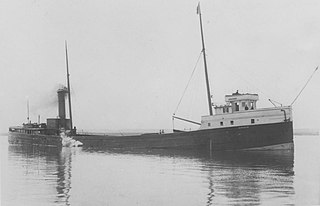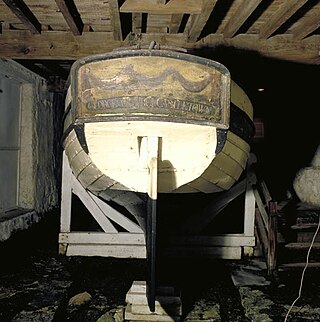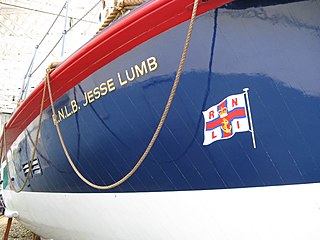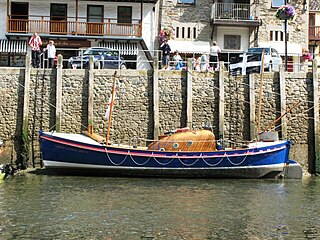
A boat is a watercraft of a large range of types and sizes, but generally smaller than a ship, which is distinguished by its larger size or capacity, its shape, or its ability to carry boats.

USS Essex was an Enterprise-class wooden-hulled armed naval steam sloop of war. She was built between 1874 and 1876 by Donald McKay at the Kitter Naval Yard of East Boston, Massachusetts. She was commissioned on 3 October 1876 by the United States Navy. On 23 December 1930 Essex was sold for scrap, and on 14 October 1931 she was taken to the beach just outside Duluth Harbor where they set fire to her; she eventually burned to the waterline. On 14 April 1994 the remains of Essex were listed on the National Register of Historic Places. Her partially surviving hulk is significant because she is the only known remnant of the work of master shipbuilder McKay.

SS Nomadic is a former tender of the White Star Line, launched on 25 April 1911 at Belfast, that is now on display in Belfast's Titanic Quarter. She was built to transfer passengers and mail to and from the ocean liners RMS Olympic and RMS Titanic. She is the only surviving vessel designed by Thomas Andrews, who also helped design those two ocean liners, and the last White Star Line vessel in existence today.

The SS Marquette was a wooden-hulled, American Great Lakes freighter built in 1881, that sank on Lake Superior, five miles east of Michigan Island, Ashland County, Wisconsin, Apostle Islands, United States on October 15, 1903. On the day of February 13, 2008 the remains of the Marquette were listed on the National Register of Historic Places.

The Little Ships of Dunkirk were about 850 private boats that sailed from Ramsgate in England to Dunkirk in northern France between 26 May and 4 June 1940 as part of Operation Dynamo, helping to rescue more than 336,000 British, French, and other Allied soldiers who were trapped on the beaches at Dunkirk during the Second World War.

Oasis of the Seas is a cruise ship operated by Royal Caribbean International. She is the first of her class, the Oasis class, whose ships were the largest passenger ships in the world, until surpassed in 2023 by the Icon class. Her hull was laid down in November 2007 and she was completed and delivered to Royal Caribbean in October 2009. At the time of construction, Oasis of the Seas set a new capacity record of carrying over 6,000 passengers. The first of her class, she was joined by sister ships Allure of the Seas in December 2010, Harmony of the Seas in May 2016, Symphony of the Seas in April 2018, and Wonder of the Seas in March 2022, as well as Utopia of the Seas in July 2024. As of November 2024, Oasis of the Seas conducts cruises in the Caribbean from her home port of Port Everglades in Fort Lauderdale, Florida.
A rescue lifeboat is a boat rescue craft which is used to attend a vessel in distress, or its survivors, to rescue crew and passengers. It can be hand pulled, sail powered or powered by an engine. Lifeboats may be rigid, inflatable or rigid-inflatable combination-hulled vessels.

Ruby and Arthur Reed was an Oakley-class lifeboat of the Royal National Lifeboat Institution (RNLI) stationed at Cromer in the English county of Norfolk from 30 April 1967 and was the No 1 lifeboat between various relief's until she was replaced after 17 years service by the Tyne-class Ruby and Arthur Reed II on 16 December 1985. During the time that the Ruby and Arthur Reed was on station at Cromer she performed 125 service launches, rescuing 58 lives.

RNLB Lloyds II was an Oakley-class lifeboat of the Royal National Lifeboat Institution (RNLI) stationed at Sheringham in the English county of Norfolk from 8 October 1990 until April 1992, when she was replaced by the Atlantic 75 second generation Rigid Inflatable Boat (RIB) Manchester Unity of Oddfellows in April 1992. During the time that the Lloyds II was on station at Sheringham, she performed 13 service launches.

RNLB J C Madge was a Liverpool-class, Pulling and Sailing non-self righting lifeboat stationed at Sheringham in the English county of Norfolk from December 1904 until June 1936 during which time she was launched on service 34 times and saved 58 lives. J C Madge was replaced by Forester’s Centenary.

Peggy is an armed yacht built in June 1789 for George Quayle (1751–1835), MHK, a politician and banker on the Isle of Man. She is the oldest surviving Manx craft and is one of only a very few surviving vessels built in the 18th century.

Kathleen and May is the last remaining British-built wooden hull three masted top sail schooner. Registered in Bideford, North Devon, but presently based in Gloucester, she is listed as part of the National Historic Fleet.

RNLB Jesse Lumb is a historic lifeboat. Built by J. Samuel White in 1939, Jesse Lumb served as the lifeboat at Bembridge on the Isle of Wight from 1939 to 1970, becoming the last of her type in service. Since 2000 she has been preserved at Classic Boat Museum, Cowes. In August 1999 she was inscribed on the National Register of Historic Vessels, becoming part of the National Historic Fleet.

Vitus Bering is a Russian icebreaking platform supply and standby vessel owned by Sovcomflot. Built by Arctech Helsinki Shipyard in Helsinki, Finland, she and her sister ship, Aleksey Chirikov, were ordered on 16 December 2010, shortly after the joint venture agreement between STX Finland Cruise Oy and United Shipbuilding Corporation had been signed. Delivered to the owners on 21 December 2012, Vitus Bering is used in the Arkutun-Dagi offshore oil field in the Sea of Okhotsk.

The Liverpool-class motorised lifeboat was a non-self-righting boat operated by the Royal National Lifeboat Institution (RNLI) from its stations around the coast of the United Kingdom and Ireland. The boats were designed for carriage launching and were developed from the Liverpool-Class Pulling and Sailing type of lifeboats - there were two types built, single and twin engined.

RNLB Lucy Lavers was an RNLI lifeboat which was on No. 2 station at Aldeburgh from 1940 until 1959 when she was placed in the reserve fleet until 1968 when she was retired. The Rescue Wooden Boats Charity is currently undertaking restoration of the vessel. The Lucy Lavers is entered in the National Historic Ships register and has the Certificate No 2206.

Australasia was a wooden-hulled American Great Lakes freighter that served on the Great Lakes of North America between her construction in 1884 to her burning and sinking in 1896. On October 18, 1896, while loaded with coal, the Australasia sank in Lake Michigan near the town of Sevastopol, Door County, Wisconsin, United States, after burning off Cana Island. On July 3, 2013, the wreck of the Australasia was added to the National Register of Historic Places.

The George Spencer was a wooden lake freighter that sank on along with her schooner barge Amboy on Lake Superior, near Thomasville, Cook County, Minnesota in the Mataafa Storm of 1905. On April 14, 1994, the wrecks of the Spencer and the Amboy were listed on the National Register of Historic Places.

The SS Lakeland was an early steel-hulled Great Lakes freighter that sank on December 3, 1924, into 205 feet (62 m) of water on Lake Michigan near Sturgeon Bay, Door County, Wisconsin, United States, after she sprang a leak. On July 7, 2015, the wreck of the Lakeland was added to the National Register of Historic Places.

The Niagara was a large wooden tugboat that sank on June 4, 1904 on Lake Superior near the town of Duluth, Minnesota, Lake County, Minnesota after running aground near Knife River. On April 14, 1994 the wreck of the Niagara was added to the National Register of Historic Places.



















